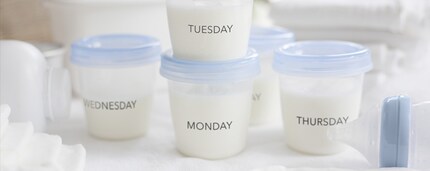
Background information
Yay, we're pregnant or help our world is upside down?
by Norina Wartmann

We accompany the couple Fabienne and Peter during their pregnancy, the birth and the postpartum period. After a few teething troubles, breastfeeding has now settled down well. Everyday family life with a newborn is always good for surprises. "Flexibility" is the magic word. Now there are more stumbling blocks.
Norina Wartmann, a freelance midwife, lovingly supported Fabienne and Peter during their pregnancy and birth. Their first child has now been born and they are spending the important and wonderful bonding time together. They have realised that breastfeeding strengthens the bond. Now it's all about using a milk pump.
You can find the couple's entire story listed at the end of the report as further topics.
"Hi Chantal, I think I have mastitis." Fabienne contacted me with these words early one Sunday morning. She has been feeling pain in her left breast since Saturday and was barely able to sleep last night because of it. In the morning, Fabienne discovered a reddening and called me.
Fabienne explains the situation to me in more detail: "I don't understand, we've been breastfeeding for three months without any problems and now this. My head is already buzzing from our move anyway. On Friday and Saturday we spent the whole day packing, unpacking and cleaning. Benjamin was looked after by my mum and always brought to me to breastfeed. I realised that he wasn't drinking well on the left. So I let him feed more on the right. There is now a red spot on his left breast towards his armpits. When I palpate it, I can feel a hardening and it hurts."
Stress can often be a reason for engorgement. This is because the stress hormone inhibits production and hinders the flow of milk. This can lead to milk stasis and bacteria can accumulate. This in turn can lead to localised inflammation with fever and other flu-like symptoms. Unfortunately, this is exactly what happened to Fabienne.
In order to relieve milk stasis and reduce inflammation, you should definitely consider these points:

Milk pumps are not only used for breast infections. If mum is absent for work or leisure, the baby can still benefit from breast milk. In rare cases, a break from breastfeeding is also necessary to maintain milk production. Simply express milk and someone else can feed the baby with it.
You can find various breast pump models on the market. Before buying, think about how often and for what purpose you need a pump. For infrequent and simple use on the go, hand pumps are practical. For everyday use, I recommend an electric model. Depending on the product, you even have both options included. Alternatively, you can also rent the pump. With both options, the health insurance companies contribute to the costs. Find out more directly from your own health insurance provider.
To ensure that pumping with a breast pump works smoothly, you should first select the right funnel size for your nipple (often included in the sets). The nipple must not rub against the funnel during suction, as this favours sore nipples. Funnels that are too large draw in too much of the areola and thus compress the milk ducts. The nipple must also be able to move freely centred in the tunnel of the bonnet during pumping.
Not every woman succeeds in expressing breast milk straight away. It is important that you feel comfortable where you are pumping milk. If you gently massage the breast before or during expressing, you will trigger the milk let-down reflex more quickly. The milk will flow more easily. A warm compress also promotes the flow of milk. If time is of the essence, both breasts can be expressed at the same time.
The milk let-down reflex is triggered several times during a breastfeeding session or pumping session. If the milk no longer flows so regularly, stimulation is needed again. The baby then sucks faster and more gently. As soon as the milk donor reflex is triggered again, the baby sucks more strongly, more regularly, more slowly and swallows audibly. This alternation between the two different sucking techniques can also be simulated with a breast pump. Depending on the model, they are even integrated and can be activated simply by pressing a button.
Some mums find it helpful to look at a photo or video of their child while pumping to stimulate the flow of milk. If possible, pumping should take place at the child's drinking rhythm when they are absent so that demand continues to regulate and meet the child's needs.
Mother's milk should be cooled as soon as possible after expressing because warm milk is a breeding ground for bacteria. However, it can be left at room temperature for up to six hours if there is no refrigeration option. It can easily be kept in the fridge for up to five days and frozen for a maximum of one year. Make sure that you only process as much breast milk as necessary. Once thawed and reheated, it should not be used again. The easiest way to heat the milk is in a warm water bath or a bottle warmer. If the milk is heated above 40 degrees, important vitamins are destroyed because they are very sensitive to heat. Excess milk can be used for baby food, for bathing, for breast milk cream or breast milk jewellery, among other things. It is also possible to extract breast milk manually using breast massage.

The sucking technique that a child practices at the breast while still in mum's womb and can usually do quickly is different from sucking on a dummy or bottle. Artificial teats should be avoided until the child has automatised breastfeeding and has mastered it without any problems. The different sucking patterns that the child is confronted with can lead to so-called sucking confusion. In the worst case scenario, the child then refuses to breastfeed. There are various ways of giving breast milk or powdered milk to the baby. There are various cups or spoons on the market for alternative feeding.
Fabienne calls me again: "The redness has disappeared and the pain is much less. The hardening is also slowly getting smaller and softer. I'm feeling much better now. Peter still has some days off work anyway because of the move and can take the pressure off me. I'm very relieved." We discuss over the phone that Fabienne will now take two more days off and continue to take care of her breasts. You can often avoid treatment with antibiotics if you treat the onset of breast inflammation immediately and correctly and take care of yourself.
Breastfeeding on the go - that's the topic of the next blog. I'll also tell you about the introduction of complementary foods and the duration of breastfeeding.
I am married and mother of two sons. As a trained nurse HF, I worked in the maternity ward of the Stans hospital and in the Lachen hospital as head of the nursing outpatient clinic.
After my further training as a lactation consultant IBCLC and as a "sleep consultant 1001kindernacht" I am currently a freelance lactation consultant IBCLC in the canton of Zug and run my own practice in Unterägeri. I am also president of the board of the association kindLine, which runs the unique family centre in the canton of Zug.<br><a href="http://stillberatung-haeusler.ch/" target="_blank">www.stillberatung-haeusler.ch</a>
Interesting facts about products, behind-the-scenes looks at manufacturers and deep-dives on interesting people.
Show all